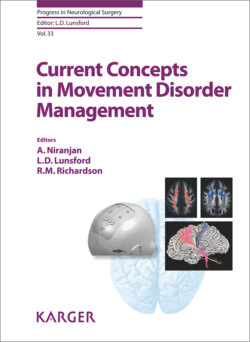Читать книгу Current Concepts in Movement Disorder Management - Группа авторов - Страница 28
Basal Ganglia Circuits
ОглавлениеAnatomic models of basal ganglia circuits, introduced in the mid-1980s, postulate that the basal ganglia, thalamus, and cortex participate in segregated reentrant loops, which originate in functionally specific cortical areas, traverse the basal ganglia and thalamus in non-overlapping regions, and then return to their respective (frontal) areas of origin [1]. The different circuits are commonly designated as “motor,” “oculomotor,” “prefrontal,” and “limbic.” It is thought that all of these circuits have a similar anatomical organization, which allows them to operate as parallel functional modules. The intrinsic and extrinsic connections of these circuits of the basal ganglia are depicted in Figure 1. Dysfunction of the motor circuit is thought to be particularly relevant to the development of movement disorders.
As shown in Figure 1, the basal ganglia receive cortical input both via the striatum and the subthalamic nucleus (STN) and via projections from the thalamus. Processing of cortical inputs to the striatum involves collateral interactions between the striatal projection neurons, as well as interactions of cholinergic and GABAergic striatal interneurons. The processed information is then conveyed to the basal ganglia output structures, that is, the internal pallidal segment (GPi) and the substantia nigra pars reticulata (SNr), via the monosynaptic “direct” pathway (Fig. 1) and the multisynaptic “indirect” pathway (Fig. 1). The latter traverses the external pallidal segment (GPe) and the STN en route to the basal ganglia output structures.
The direct and indirect pathways are thought to exert opposing influences upon GPi and SNr. The direct pathway acts to inhibit GPi/SNr, which then reduces the inhibitory output of GPi/SNr to targets in the thalamus and brainstem. The resulting release of thalamic activity from the GPi/SNr inhibition allows increased activity in the thalamocortical projection neurons, and, thus, increased cortical activity and facilitation of movement. Activation of the indirect pathway has the opposite effect, activating basal ganglia output, which inhibits movement.
The direct and indirect pathways are differentially regulated by dopamine. The striatal source neurons of the indirect pathway carry D2 dopamine receptors whose activation leads to the inhibition of these neurons. By inhibiting activity along the indirect pathway, D2 receptor activation will reduce the basal ganglia output from GPi/SNr. In addition, activation of D1 dopamine receptors which are primarily expressed on striatal neurons that give rise to the direct pathway, leads to greater activity in these GABAergic neurons, resulting in increased inhibition of their GPi/SNr targets, and subsequent disinhibition of brain regions downstream from GPi/SNr. Via the combined actions on D1- and D2-type receptors in the striatum, dopamine will thus act to reduce the activity of neurons in GPi/SNr, which will eventually facilitate movement.
Activation of the cortico-subthalamic projection (part of the so-called “hyperdirect” pathway; Fig. 1) stimulates the excitatory projection from the STN to the GPi, and thus inhibits basal ganglia-receiving areas of the thalamus and brainstem. It may also influence the GPe projection to the striatum. This pathway may have a role in limiting motor responses or in the quick cancellation of ongoing movement.
Other pathways of the basal ganglia have recently gained prominence in studies describing the pathophysiology of PD and other conditions, specifically the GPe projection to the striatum, and descending STN and GPi projections to the pedunculopontine nucleus (PPN) and other areas of the brainstem. Projections from the thalamus back to the striatum may also be of relevance in basal ganglia diseases. Thalamic areas that receive input from the basal ganglia motor circuit project to large portions of the frontal cortex, specifically the supplementary motor area, the premotor cortex, and the primary motor cortex (M1).
